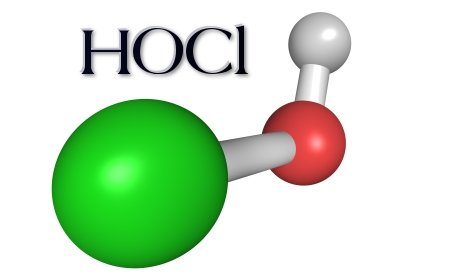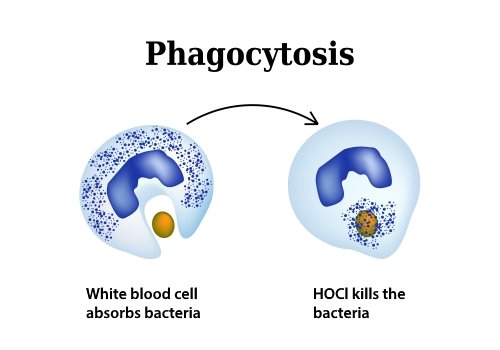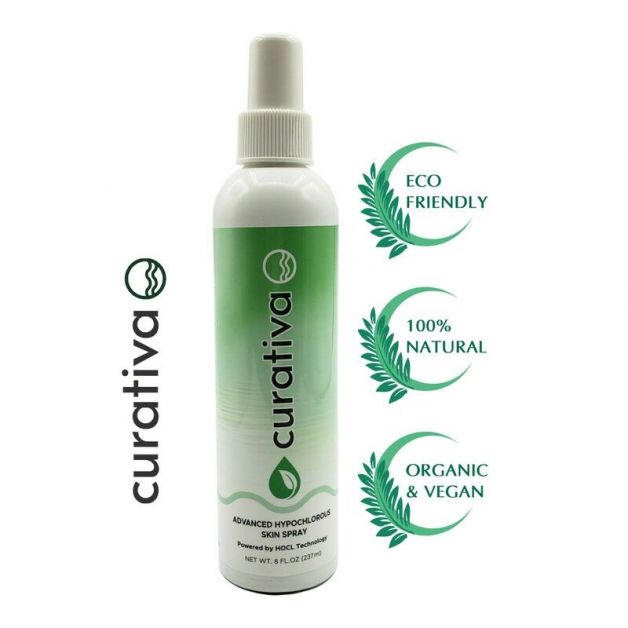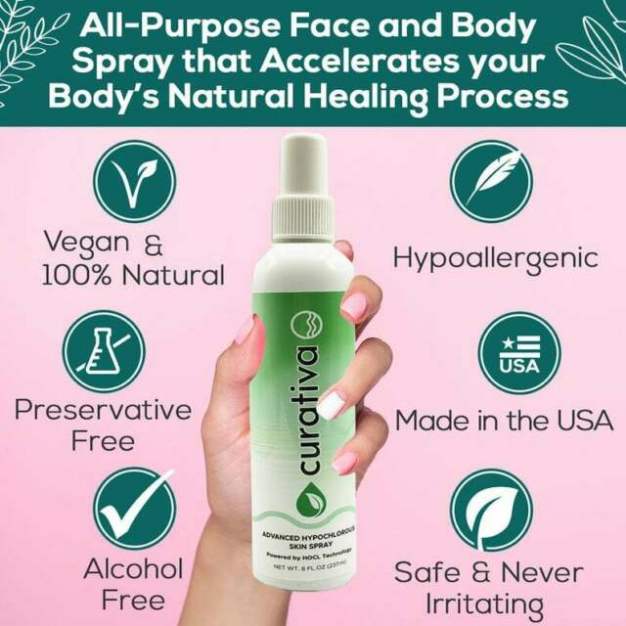


Hypochlorous acid ("HOCl") kills many types of bacteria, viruses, and fungi to fight infection, heal wounds, and keep skin young.




Your skin changes with age. It becomes thinner, loses fat, and no longer looks as plump and smooth as it once did. Your veins and bones can be seen more easily. Scratches, cuts, or bumps can take longer to heal. Years of sun tanning or being out in the sunlight for a long time may lead to wrinkles, dryness, age spots, and even cancer. But there are things you can do to protect your skin and to make it feel and look better.
Many older people suffer from dry skin, often on their lower legs, elbows, and lower arms. Dry skin feels rough and scaly. There are many possible reasons for dry skin, such as
Dry skin also can be caused by health problems, such as diabetes or kidney disease. Using too much soap, antiperspirant, or perfume and taking hot baths will make dry skin worse.
Because older people have thinner skin, scratching can cause bleeding that may lead to infection. Some medicines make the skin itchier. If your skin is very dry and itchy, see your doctor.
Moisturizers like lotions, creams, or ointments can soothe dry, itchy skin. They should be used every day. Try taking fewer baths and using milder soap to help your dry skin. Warm water is less drying than hot water. Don't add bath oil to your water -- it will make the tub too slippery. Some people find that a humidifier (an appliance that adds moisture to a room) helps.
Find more home care solutions and tips for managing dry skin.
Older people may bruise more easily than younger people. And, it can take longer for the bruises to heal. Some medicines or illnesses may cause bruising. If you see bruises and you don't know how you got them, especially on parts of your body usually covered by clothing, see your doctor.
Over time, skin begins to wrinkle. Things in the environment, like ultraviolet (UV) light from the sun, make the skin less elastic. Gravity can cause skin to sag and wrinkle.
Certain habits also can wrinkle the skin. Some of these habits are easier to change than others. You may not be able to change your facial expressions, but you can quit smoking.
A lot of claims are made about how to make wrinkles go away. Not all of them work. Some can be painful or even dangerous, and many must be done by a doctor. Talk with a doctor specially trained in skin problems (a dermatologist) or your regular doctor if you are worried about wrinkles.
Age spots, once called "liver spots," are flat, brown spots often caused by years in the sun. They are bigger than freckles, and many times show up on areas like the face, hands, arms, back, and feet. Age spots are harmless, but if they bother you, talk to a dermatologist about removing them. Also, a sunscreen may prevent more sun damage.
Skin tags are small, usually flesh-colored growths of skin that have a raised surface. They are a common occurrence as people age, especially for women. They are most often found on the eyelids, neck, and body folds such as the arm pit, chest, and groin. Skin tags are harmless, but they can become irritated. A doctor can remove them if they bother you.
Syndicated Content Details:
Source URL: http://nihseniorhealth.gov/skincareandaging/howagingaffectsskin/01.html
Source Agency: NIH Senior Health (NIHSH)
Captured Date: 2015-11-13 13:15:00.0

Aloe is a succulent plant widely used in alternative medicine. There are at least 420 different plant species of Aloe. Aloe vera specifically refers to the Aloe barbadensis Miller plant, which is the most common form used in Aloe-based products.
Traditionally, the clear gel from the Aloe plant is rubbed on the skin as an ointment to treat wounds and burns. The green part of the leaf can be made into a juice or dried and taken orally as a laxative. Aloe vera is used in many commercial products in various forms, including drinks, concentrates, capsules, powders, and as a flavoring.
Applying Aloe vera gel on the skin is not likely to cause harm. Although these particular NTP studies only looked at oral exposure to Aloe vera, other NTP studies examined the effects of the gel on the skin and did not find a strong link between Aloe vera in skin care products, sunlight, and the development of skin cancer. The results of those skin studies were reported in the NTP Technical Report 553 on the Photococarcinogenesis Study of Aloe Vera.
Product advertisements claim the drinks can be used to cleanse the digestive system or relieve constipation.

The outer pulp of Aloe leaves, known as the latex, contains anthraquinones. Aloin is an anthraquinone found in the latex that may give the plant its laxative qualities.
There are very little data about what the levels of aloin are in the consumer products. According to published research, levels of aloin in most liquid products are less than 1 part per million (ppm); however, levels in solid or semi-solid products may be 10-100 times higher.
This is not clear. Industry usually processes the Aloe vera leaf to make a decolorized whole leaf extract to remove aloin. Industry has a self-regulated upper limit standard of 10 ppm of aloin in orally ingested products, but there are no labeling requirements for aloin content.
More research is needed to answer this question. In rodents, it caused intestinal tumors. If you are concerned, have a medical condition, or are taking other drugs, herbs, or supplements, you should speak with your physician before altering existing treatments or starting any new treatment.
This is not clear, as there are no labeling requirements to list aloin content. The concentration of aloin in the water that the rodents drank in the NTP study is similar to that found in some Aloe vera products, but higher than in other products. The NTP wanted to test an Aloe preparation that includes all components that may be in the products on the market. The NTP study used a whole leaf extract of Aloe barbadensis Miller that did not undergo charcoal filtration during processing. Many commercial producers of Aloe vera beverages use charcoal filtration to reduce the levels of aloin in their products.
Aloe vera is a dietary supplement and not a regulated drug. There is no guarantee of strength, purity, or safety of these products. Aloe vera is approved by the Food and Drug Administration as a food additive for flavor.
The two-year NTP study on consumption of non-decolorized whole leaf extract of Aloe vera found clear evidence of carcinogenic activity in male and female rats, based on tumors of the large intestine.
From what we know right now, there is nothing that would lead us to believe that these findings are not relevant to humans.
However, more information, including how individuals use different types of Aloe vera products, is needed to determine the potential risks to humans.
The NTP rat studies give cause for serious concern. Some questions that need to be answered before their importance can be fully appreciated include:
There is not enough information currently available to know how much Aloe vera people are consuming or for how long. Based on what we know right now, there is nothing that would lead us to believe that this finding would not be relevant to humans.
We suspect the aloin but are not sure. We hope to do more studies to determine what may be causing the tumors.
That is a decision you might want to make with your health care provider. Like any personal decision, the more information you have the better. Currently, manufacturers of these products are not required to label aloin concentration in Aloe vera products. If aloin is the cause of the tumors in rats then, generally speaking, the lower the concentration of aloin in a product, the lower the possibility that it may cause harm. Tumors developed in animals that drank water containing 60 ppm of aloin daily for nearly their entire lifetime.
Syndicated Content Details:
Source URL: https://www.niehs.nih.gov/health/topics/agents/aloe/index.cfm
Source Agency: National Institute of Environmental Health Sciences (NIEHS)
Captured Date: 2017-02-24 19:28:00.0